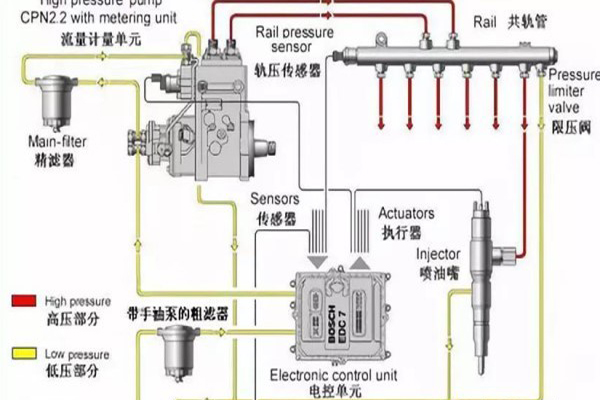The structure principle and failure maintenance of the hand oil pump of the truck crane
There are many failure points in the oil circuit of the truck crane, and the troubleshooting is more complicated. The low-pressure oil circuit of the diesel engine does not deliver oil or the oil is low. There are many factors involved, and it is easy to make detours and also delay time. And is there a simpler and faster way to check the oil circuit failure?
1. The construction principle of hand oil pump
1. The manual oil pump is composed of four parts: pump body part, handle part, oil storage tank, rear seat part
(1) Pump body part: The pump body part is the main part of the oil pump, high pressure working chamber, low pressure working chamber, two one-way valves, high pressure valve (safety valve), low pressure valve, unloading valve, two check valves, inlet The oil ports are all above. The holes are connected organically.
(2) Two one-way valves are to prevent backflow of pressure oil. The specifications and functions of the two check valves are the same. The function of low pressure valve and high pressure valve is pressure control. Control the pressure at 1.5MPa and 63MPa respectively. The two steel balls at the oil inlet are check valves. After the work is completed, the unloading valve is loosened and the pressure oil flows back to the oil storage pipe to complete the unloading work.
(3) Handle part: mainly composed of pressing rod and pressing handle. It is connected with the pump body and the plunger by two pins. The manual force acts on the pressure rod to drive the plunger to reciprocate and generate oil pressure.
(4) There are oil filling and vent holes on the rear seat or the oil tank. The deflation and air intake can be performed by loosening the screw. Please open the air release valve when using.

2. Basic use of hand oil pump:
When there is air in the oil passage of the diesel engine, such as a new car that has just rolled off the assembly line, or the oil in the fuel tank is burned out, the engine cannot be started when the engine is started, because the diesel fuel pump can only work when the engine is started. At this time, it is necessary to pump the fuel in the fuel tank into the tunnel with a hand fuel pump. (First loosen the exhaust bolt on the fuel injection pump until the bubbles are exhausted)
3. Working principle of hand oil pump:
When the piston moves upward, the volume in the pump cavity expands to form a vacuum, so the check valve 2 is closed under the action of the spring, and the check valve 1 opens under the action of atmospheric pressure, and the fuel enters the pump cavity through the oil inlet pipe.
When the piston moves downwards, the oil pressure in the pump chamber rises, closing the one-way valve 1 and opening the one-way valve 2, the fuel is discharged from the oil outlet, and the cycle continues, and the driving pump continues to deliver fuel.
2. Maintenance skills
Here are a few tips to share with you. By comparing the different feelings and changes of the hand oil pump with the normal oil coming in, you can find out some of the fault causes quickly.
1. The oil circuit has suction
Loosen the oil passage to deflate the oyster nails, pump oil with the oil pump by hand, and gently pull the handle upwards, if you feel a little suction in the oil passage, when you press the handle, there is less fuel discharged from the deflation nail, indicating that the oil suction resistance of the oil pump is too large.
The reason for the decrease of incoming oil is: the vent hole on the fuel tank cover is blocked, and negative pressure appears in the fuel tank, which affects the incoming oil: the diesel oil used in winter has excessive viscosity and poor fluidity.
2. There is mixed gas in the drain oil
When pumping oil, the fuel overflowing from the bleeder nail is mixed with gas. If you feel resistance when you press the handle, and the fuel discharged at the same time is low, the filter element or oil path between the fuel transfer pump and the high-pressure fuel pump is blocked. cut back.
3. The vehicle can‘t catch fire, it can be started by pumping oil by hand oil pump
The vehicle has been unable to catch fire, and it can catch fire by pumping oil with a hand oil pump, but the engine stalls immediately after stopping. Generally, there is a pressure relief point in the oil circuit system, which leads to insufficient pressure and fuel cannot be delivered to the engine. Check where the pressure is relieved in the oil circuit.
4. The output fuel is mixed with gas
When pumping oil, the fuel output from the oil drain screw is mixed with gas; the oil pipe joint from the oil drain screw to the oil pump is not tightened; the joint gasket is damaged or the oil circuit is damaged, etc., causing air leakage, from the threaded connection on the oil pump Or the gas is sucked in the gap between the piston of the hand oil pump and the outer wall; the fuel injector assembly is stuck in the open position, the oil outlet valve is not well sealed, and the high pressure gas in the fuel chamber rushes into the low pressure oil circuit (the gas can be quickly discharged by the hand oil pump, However, gas will be introduced after starting); the oil level of the fuel tank is too low to suck air; the oil path from the fuel tank to the fuel pump is seriously blocked, and it is easy to inhale gas.
5. Low resistance at the handle
Do not loosen the air nail. If you press the handle for a long time and always feel less resistance, it is because the oil return valve on the high-pressure oil line or the oil inlet and outlet valves in the oil transfer pump have poor sealing and oil leakage.
Reason: the valve surface is severely worn; the valve surface is stained with impurities; the valve spring is damaged.
When we are checking, we can check out the general failure points of the engine through some of the engine‘s own auxiliary devices. As long as the scope is determined, the specific reasons are easy to deal with, so we must be good at using effective methods to find them more quickly And solve the engine failure.
3. Failure case
A HOWO A7 heavy-duty vehicle, after changing the oil and three filters, it will not catch fire. The starter fluid can be sprayed and the engine will not catch fire for more than ten times. The instrument panel displays the fault code 639, which is not checked. Go to the corresponding fault code table.
1. Check the fine filter, low pressure oil line pressure
Loosen the oil drain screw of the fine filter. There is no air at all. The consulting service station said that the pressure in the high-pressure oil circuit cannot be reached. In this case, it can only be started several times. The injector can only be used after the high-pressure oil circuit reaches the working pressure. The engine can catch fire only after fuel injection, and the engine still won‘t catch fire after repeated start.
2. Check the low pressure oil circuit again
There is no air when the coarse filter and the fine filter are emptied. There are two reverse flow valves between the fine filter and the high-pressure oil pump. The function is to build a certain pressure in the low-pressure oil circuit. The first reverse valve is removed and the seal is not tight. After blowing with the mouth, the air leaked. After cleaning, the sealing function was restored. The second one was the reverse valve close to the high-pressure oil pump. After opening, a small piece of hard object was found at the seal between the steel ball and the pipeline. Look at the filter. The adhesive glue at the junction of the inner paper core and the end cap has fallen off. Judging from the disassembly and inspection process of the two reverse flow valves, the filter is seriously damaged. At this time, the fault code 639 on the dashboard was still there. I thought it could be started if the fault was found, but the fault persists. The service station personnel are also helpless. A teacher judged that the oil problem is still there.
3. Check the oil circuit for the third time
This time, I started to check the high-pressure oil circuit and opened the high-pressure oil pipe screw. The oil pump found that there was oil at the injector end of the high-pressure oil pipe without air, but there was not much pressure. This is the case for each cylinder. Tighten all pipe joint screws and start the engine again. , Still the same. Take a closer look. At the front end of the high-pressure common rail, there is an oil pipe connecting screw. Gently loosen it and press the oil pump several times. The loosened screw removes a small amount of air, and then tighten it. At this time, the instrument The fault code 639 on the disk disappeared, and the startup was successful as soon as the key was turned.
Summary: From the very beginning, the pressure of the low-pressure oil circuit is not high. Check the reverse flow valve and find foreign objects. Its failure is mainly caused by the inferior filter. Then a small part of the air enters the common rail system during the exhaust process. So little air enters the common rail system, which makes the high-pressure oil circuit unable to reach the working pressure and the engine cannot start.










.png)
.png)